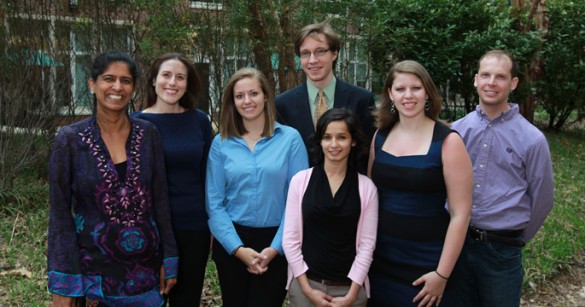
A strategy for commercializing an optical 3-D scanner that can ensure all cancerous breast tissue is removed during surgery, thereby avoiding the need for a second operation, has won top honors at this year’s TechVenture Challenge.
Now in its fourth year, the Vanderbilt University initiative teaches students how to turn patented ideas developed by Vanderbilt faculty members into marketable products.
This year five teams of graduate, business and law students developed over the course of eight weeks strategies for commercializing different Vanderbilt inventions, and presented them to a panel of judges with expertise in technology entrepreneurship.
The competition, held April 10 at the Nashville law firm Bradley Arant Boult Cummings, was co-sponsored by the Vanderbilt Center for Technology Transfer and Commercialization (CTTC) and the Life Science Tennessee Academic Alliance, part of Life Science Tennessee.
The winning presentation pitched OMEDS, a three-dimensional scanner that uses light to analyze cancerous tissue removed during breast-conserving therapy and the surgical “margins” in the breast to ensure all cancer cells have been removed before the patient leaves the operating room.
Currently, this analysis is done after surgery in the clinical pathology lab and as a result, about a fifth of patients must return for a second operation, said Meghan McGill, an MBA student in the Owen Graduate School of Management who presented the case.
The judges noted that while hospitals make more money from higher surgical volumes, fewer operations are “clearly better for the patients.” OMEDS can succeed in the marketplace if it can bring what makes “medical sense” in line with what makes “economic sense,” they said.
The technology was developed by Anita Mahadevan-Jansen, Ph.D., Orrin H. Ingram Professor of Biomedical Engineering and professor of Neurological Surgery; Quyen Nguyen, Ph.D., postdoctoral fellow in Biomedical Engineering; Mark Kelley, MD, associate professor of Surgery; and Mary Dockery, a graduate student in Biomedical Photonics.
Other team members were Diksyha Bastakoty, a graduate student in the Department of Pathology, Microbiology and Immunology; Ryan Ceddia, a graduate student in the Department of Medicine; Barbara Natalizio, Ph.D., a postdoctoral research fellow in the Department of Cell and Developmental Biology; and Miroslav Remec, an undergraduate in Physics.
Dan Bailey, MBA, of Insight Genetics in Nashville, served as business mentor.
Each team member received a $250 prize.












